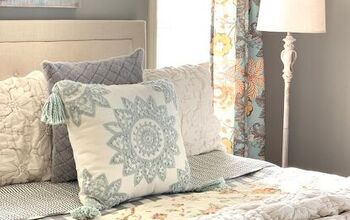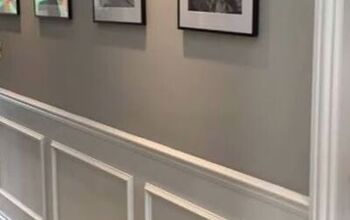Bedroom Decorating: My Guide to Creating Your Dream Sanctuary

Today I'm diving into one of my favorite topics: bedroom decorating. Whether you’re starting from scratch in a new home or looking to refresh your current bedroom, I’ve got you covered with a comprehensive guide to create a space that’s not only stylish but also a sanctuary for relaxation and rejuvenation. So, let’s get started!
Table of contents
- Why the Bedroom Matters
- Step 1: Define Your Style
- Step 2: Start with the Bed
- Step 3: Mix Patterns and Textures
- Step 4: Consider Scale and Proportion
- Step 5: Layer Your Lighting
- Step 6: Create a Clutter-Free Space
- Step 7: Don’t Forget Wall Decor
- Step 8: TV in the Bedroom?
- Step 9: Accessorizing Your Space
Why the Bedroom Matters
Bedrooms are one of my favorite spaces to design, but they’re also one of the most common pain points for my clients. I truly believe that the bedroom should be a sanctuary, not a place of stress. You deserve a place to rest and feel comforted by beauty. So, grab a pen and paper, and let’s talk about how to create a space that is serene.
Step 1: Define Your Style
The foundation of any successful design is defining your style. Take some time to explore different design aesthetics like minimalistic, modern, traditional, or coastal. Look for inspiration on platforms like Pinterest, Instagram, or in interior design books. I also have two videos on interior design styles that can help you figure this out—just click here to watch the first one.
Identify colors, patterns, and textures that speak to you and reflect the mood you want to achieve in your bedroom. I recommend creating a mood board or a digital folder to visualize and refine your ideas. A mood board is simply a visual display of your design choices that helps you ensure your design is cohesive.
Step 2: Start with the Bed
Once you’ve decided on the style, start with the bed. Your bed is the centerpiece of your bedroom, so it makes the most sense to start here.
Consider a statement headboard to really anchor the space. Upholstered headboards are great for warmth and softness, while sleek and modern headboards like wood or metal are perfect for a minimalistic vibe.
Invest in high-quality bedding that feels soft and indulgent—remember, this space is supposed to be an oasis of comfort. Opt for sheets with a high thread count, and layer pillows of different sizes and textures. Mixing solid colors with patterns and a variety of throws and blankets adds depth and coziness.
If you’re on a budget, I often recommend looking for bedding at Target, TJ Maxx, or HomeGoods—they have great options!
Step 3: Mix Patterns and Textures
Add visual interest and depth to your bedroom decor by thoughtfully mixing patterns and textures. Pair bold patterns with solid colors or smaller-scale prints to create a balanced and cohesive look. You can also layer rugs, throw pillows, and upholstered furniture with varying textures to add warmth and visual appeal while enhancing the overall aesthetic of your bedroom decor.
Step 4: Consider Scale and Proportion
Pay attention to scale and proportion when selecting furniture and decor for your bedroom. A large bed may require substantial bedside tables or nightstands with lots of storage space for books, lamps, and personal items.
If your nightstands are too small compared to the visual weight of the bed, the room will feel off.
In a smaller bedroom, look for space-saving furniture and multi-functional pieces that serve dual purposes, such as a bedside table with built-in drawers or a storage ottoman at the foot of the bed.
Arrange furniture to create a balanced and harmonious layout that allows for easy movement and access to essential items while maximizing floor space and functionality. I almost always recommend placing your bed on the wall you first see when you open the door.
Step 5: Layer Your Lighting
Lighting is another crucial element. Layer lighting in the space to enhance the ambiance and functionality of your bedroom. Start with ambient lighting, such as an overhead fixture, to provide overall illumination. Not everyone can have a chandelier in their bedroom, and it’s an incredibly common debate between married clients about whether or not they need a fan in the bedroom. But personally, I think a chandelier takes the space to a whole new level!
Add task lighting and incorporate accent lighting as well. A common issue in bedroom designs is the lack of balanced lighting, so you don’t just need lamps on your nightstands—you might also want one on the dresser. And if you have a chair in the corner, consider putting a floor lamp there too. You can also install dimmer switches to control light intensity and set the mood according to different times of day.
Maximize natural light by choosing window treatments that allow you to adjust privacy and brightness while bringing in natural daylight.
Step 6: Create a Clutter-Free Space
Creating a clutter-free space promotes relaxation and tranquility. This is huge! When possible, your bedroom should not have a desk or exercise equipment—those don’t promote relaxation. Invest in smart storage solutions to keep essentials organized and out of sight. Choose bedside tables with drawers to store books, electronics, or nighttime essentials. Utilize under-bed storage bins for seasonal clothing or extra linens.
Keep surfaces clear to create a clean and serene environment conducive to rest and rejuvenation. You deserve to have a space that feels calming, so come up with ways to keep spaces clean and clear, especially your nightstands.
Step 7: Don’t Forget Wall Decor
Blank walls are a missed opportunity, and rather than feeling minimalistic, they can feel sterile and incomplete. Hang art that resonates with you, whether it’s a gallery wall of family photos, a serene landscape, or abstract prints. Mirrors reflect light and make the room feel more spacious, so hang a mirror above your dresser or use a full-length mirror in the corner of the room.
A lot of people struggle with what to hang above the bed. I recommend simplicity—choose three small framed prints or even two larger prints. You can also opt for something long and narrow if your headboard is really tall. I’ve also placed mirrors behind nightstands before, and that’s another great look to consider.
Step 8: TV in the Bedroom? Let’s Talk
Now, let’s talk about having a TV in the bedroom. Personally, I don’t love the look of a large, dark screen in my bedroom. If you don’t want a Frame TV, you could consider installing your TV into the wall and covering it with mirrors or art on a sliding mechanism. That way, when it’s time to watch TV, you can slide it away and watch. When you’re done, you get the beauty of art or mirrors instead of a TV.
Step 9: Accessorizing Your Space
This is another area where clients often need help. The number one thing I see is too many photo frames on tabletops. My solution? Select just a few of the most meaningful ones and use the rest somewhere else in the home, like in a gallery wall or on a dresser.
To maintain simplicity, I recommend keeping it minimal. You could have a lamp on one side, maybe floral arrangements or candlesticks on the other, with a tray in the middle for your perfumes or books. On a nightstand, you need a lamp, of course, and maybe a small greenery or clock, but leave some space clear for your devices as they charge.
Final Thoughts: Make Your Bedroom a Haven
Remember, the goal and purpose of a bedroom is not to display all your favorite items—it’s to promote peace and tranquility. Consider moving easily cluttered items to your office or a bookcase.
By following these steps, you can transform your bedroom into a haven that promotes relaxation and reflects your unique style. The key to successful interior design lies in balancing functionality with aesthetics, creating a space that not only looks beautiful but also feels comfortable and inviting.
I hope you found this guide helpful! Let me know your thoughts in the comments below.








































Comments
Join the conversation